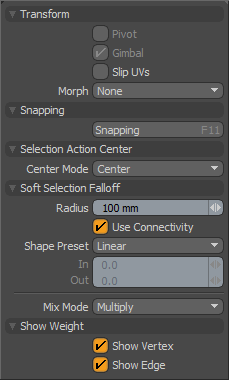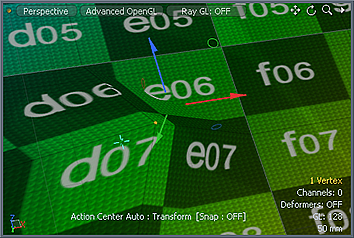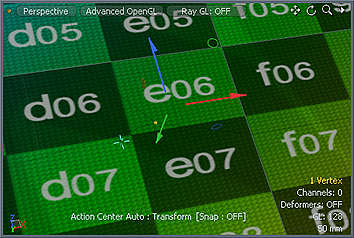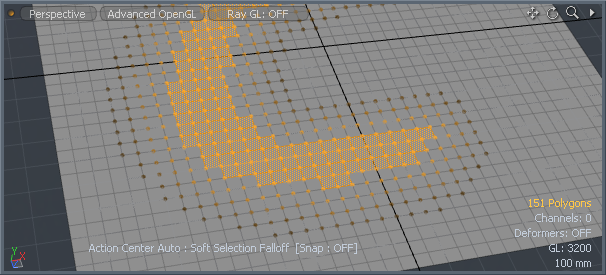 Found in the 'Deform' subtab of the modeling toolbox (sometimes as a subtool of one of the other Soft Selection Tools), the Soft Select Rotate tool is a deformation tool that rotates the selected geometry rigidly, while gradually attenuating the rotation amount outside of the selected area defined by the Soft Selection 'Radius'. As the Radius increases, so does the softness of the transformation.
Found in the 'Deform' subtab of the modeling toolbox (sometimes as a subtool of one of the other Soft Selection Tools), the Soft Select Rotate tool is a deformation tool that rotates the selected geometry rigidly, while gradually attenuating the rotation amount outside of the selected area defined by the Soft Selection 'Radius'. As the Radius increases, so does the softness of the transformation.
Transform--
Pivot: Disabled for the 'Soft Select Rotate' tool.
Gimbal: Disabled for the 'Soft Select Rotate' tool.
Slip UVs: UV values are generally fixed to specific vertices, subsequently further edits to the geometry may warp, deform or otherwise distort the UV values in undesirable ways requiring users to adjust the map or redo it altogether. To avoid this undesirable result, users can enable the 'Slip UVs' function so as to not disturb any existing UV mapping applied to the geometry.
 'Slip UVs' function disabled, note texture warping. |  'Slip UVs' function enabled, texture remains even. |
Morph: (Only in Component Modes) The Morph option determines how MODO treats stored Morph information when applying transforms to geometry (Move, Rotate, Scale, etc.). In previous versions of MODO, in order to transform a Morph along with its base, it needed to be selected in the Vertex Map list. If it wasn't, relative Morph map data when recalled would produce distorted, undesirable results. If users were unaware of the requirements, it was easy to accidentally mess up a model. To remedy this problem, there are now three options controlling how the Morph Map vertex data is dealt with when applying any transforms--
None- Unselected Morph data is not affected, though selected (visible) Morphs can still be transformed independent of their source.
Transform- With this option selected, Morph data is transformed along with base mesh.
Keep Positions- With this option Selected, Morph data is converted into a Absolute Morph Map and all vertices retain their pre-transformed positions.
Snapping--
Please reference the 'Snapping' Section of the documentation.
Selection Action Center--
Please reference the 'Action Centers' page of the documentation.
Soft Selection Falloff--
Radius: Determines the range outside of the selected edge to attenuate the falloff.
Use Connectivity: When enabled only affects single surface/connected elements, unconnected elements within range will be ignored.
Shape: The strength of the Falloff's influence can be controlled along the extent using a 'Shape Preset'-
Linear- Attenuation of Falloff occurs evenly across its range.
Ease-In- Strength of Falloff is greater toward the 'Start' position.
Ease-Out- Strength of Falloff is greater toward the 'End' position.
Smooth- Strength of Falloff is greater toward the center of the Falloff.
Custom- Users can use the 'In'/'Out' options to fine tune strength of Falloff.
In/Out: The 'In' value determines the strength of the Falloff nearer to the 'Start' position, where the 'Out' value determines the strength on nearer the 'End' side of the Falloff.
Mix Mode: In instances where there are multiple falloffs applied to a transform (using the 'Add' option of the Falloff menu), the mix mode defines how each Falloff interacts with the other.
Show Weights--
Show Vertex/Show Edge: Users can use these toggles to enable/disable the display of geometry highlights for both vertices and edges, giving a visual reference to the application of the Soft Selection falloff (demonstration of the vertices display mode below).



